Zoom
Trash
Related: Arrow
- Arrow
- Arrow (TV Series 2012– )
- Arrow | Series on The CW | Official Site
- Education
- Enterprise

Dornier Do-335 A-6 Nightfighter. Category:Dornier Do 335. Do 335 Pfeil Heavy Fighter. Camouflage of the Dornier Do 335: A Critical Re-evaluation by Michael Ullman. Aircraft: Do 335 Pfeil. ASN Aircraft accident 18-JAN-1946 Dornier Do 335A-12 AM223. Do 335. Dornier-Arrow. Reviving a principle patented in 1937, Dornier designed the radical centerline-thrust Do 335 to a 1942 requirement for a day/night fighter, fighter-bomber and reconnaissance aircraft.
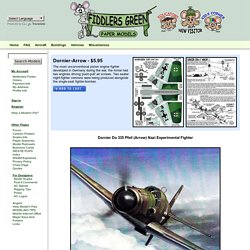
Throughout the history of military aircraft design few successful warplanes justifiably claiming iniquity at their birth have retained this status for any great length of time, the features rendering them unique invariably being plagiarized by their competitors. An exception among piston-engine fighters was the Do 335 which was unique at conception and was destined to remain so. Popularly known during its brief existence as the Pfeil (Arrow), the Do 335 was radical rather than revolutionary. Its center-line thrust concept was not new in itself. Dornier Do 335. Dornier Do 335A Pfeil Photo Walk Around. Dornier Do 335. By Heinz J.Nowarra, Edward T.
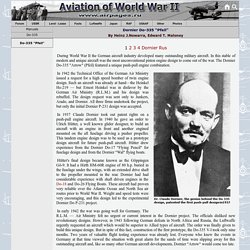
Maloney During World War II the German aircraft industry developed many outstanding military aircraft. In this stable of modern and unique aircraft was the most unconventional piston engine design to come out of the war. Dornier Do 335 - Aircraft Wiki. 测试敌人的箭——法国人眼中的 Do-335. 测试敌人的箭.
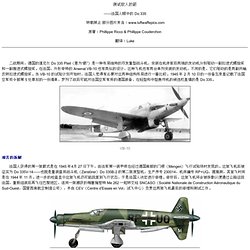
Dornier Do 335 Pfeil. No-one can accuse the World War II German aircraft designers of conservatism and, while the majority of combat aircraft were of conventional design, there were many others which pushed the forefront of aeronautics.
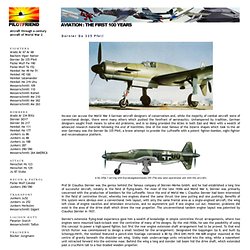
Unhampered by tradition, German designers sought fresh means to solve old problems, and in so doing provided the Allies in both East and West with a wealth of advanced research material following the end of hostilities. Dornier Do 335 - experimental attack plane. Dornier Do 335 - Military. The Dornier Do 335 Pfeil ("Arrow") was a World War II heavy fighter built by the Dornier company.

The two-seater trainer version was also called Ameisenbär ("anteater"). The Pfeil's performance was much better than other twin-engine designs due to its unique "push-pull" layout and the much lower drag of the in-line alignment of the two engines. The Luftwaffe was desperate to get the design into operational use, but delays in engine deliveries meant only a handful were delivered before the war ended. Development Edit The origins of the Do 335 trace back to World War I when Claudius Dornier designed a number of flying boats featuring remotely-driven propellers and later, due to problems with the drive shafts, tandem engines. There are many advantages to this design over the more traditional system of placing one engine on each wing, the most important being power from two engines with the frontal area (and thus drag) of a single-engine design, allowing for higher performance.
Flight tests. Dornier Do 335 Pfeil. Type: Military If you've flown the Dornier Do 335 Pfeil please write a review for it.
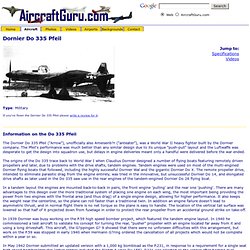
Information on the Do 335 Pfeil. Dornier Do 335 Pfeil. No-one can accuse the World War II German aircraft designers of conservatism and, while the majority of combat aircraft were of conventional design, there were many others which pushed the forefront of aeronautics.

Unhampered by tradition, German designers sought fresh means to solve old problems, and in so doing provided the Allies in both East and West with a wealth of advanced research material following the end of hostilities. Aeroflight » Dornier Do 335. Aircraft Profile The last surviving example, Do 335A-0 VG+PH, seen after restoration by Dornier.

(photo, Dornier) Key Facts Development. Dornier Do 335 Pfeil (Arrow) - Fighter-Bomber / Heavy Fighter. The Dornier Do 335 Pfeil (or "Arrow") was one of the more unique prop-driven designs of the Second World War.
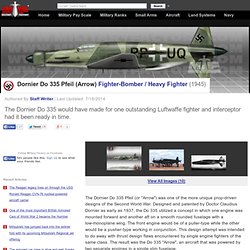
Designed and patented by Doctor Claudius Dornier as early as 1937, the Do 335 utilized a concept in which one engine was mounted forward and another aft on a smooth rounded fuselage with a low-monoplane wing. The front engine would be of a puller-type while the other would be a pusher-type working in conjunction. This design attempt was intended to do away with thrust design flaws encountered by single engine fighters of the same class. The result was the Do 335 "Arrow", an aircraft that was powered by two separate engines in a single slim fuselage. The twin engine design accommodated the pilot in a glazed canopy offering good visibility forward, to the sides and above. Initially appearing as a research aircraft Goppingen Go 9 in 1939, the system was later put through trials and accepted as a Do P.231 type high-speed bomber.
Text ©2003-2014 www.MilitaryFactory.com. Crew: 1. Luftwaffe Resource Center - Fighters/Destroyers - A Warbirds Resource Group Site. Dornier Do 335 The Dornier Do 335 Pfeil ("Arrow") was a World War II heavy fighter built by the Dornier company.
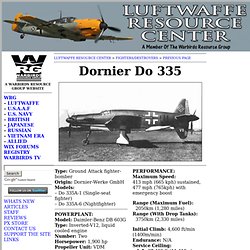
The two-seater trainer version was also called Ameisenbär ("anteater"). The Pfeil's performance was much better than other twin-engine designs due to its unique "push-pull" layout and the much lower drag of the in-line alignment of the two engines. The Luftwaffe was desperate to get the design into operational use, but delays in engine deliveries meant only a handful were delivered before the war ended. Do335. Select A Section ... Introduction As the Second World War in Europe drew to a close, a powerful new twin- engined fighter was preparing to enter service with the Luftwaffe. The unique configuration of this aircraft conferred on it a phenomenal performance, which completely eclipsed all of its contemporaries; whilst its potential for devastating the massive Allied bomber streams that almost daily pounded the Reich was rivalled only by the Me262 jet.
This amazing machine was the piston-engined Dornier Do335. Aircraft designers are constantly seeking to maximize engine power and minimize drag. The Web Site of the 225th AAA Searchlight Battalion: The Do335 "Arrow" at Unter Biberg. By Merle Olmsted, via C. E. Bud Anderson.com(Reprinted from the Journal of the American Aviation Historical Society, Summer 1997) Start with a US airbase in recently defeated Germany, add one strange, exotic airplane, and stir well. The crowd, from hangars, shops, offices, clubs, and ramps, will appear like magic. Rare color photos of Dornier Do335 "Arrow" - MAIN PAGE. Specifications:Wingspan: 45' 4" Length: 45' 6" Height: 16' 4" Weight empty: 16,314 lbs.
(A-1), 16,975 lbs. (A-6) Maximum weight: 25,800 lbs (both versions) Maximum speed: 413 mph (sustained), 477 mph (emergency boost) Service ceiling: 37,400 feet (A-1), 33,400 feet (A-6) Maximum range: 1280 miles, 2330 with external drop fuel tanks Data from:Aero Series - Dornier Do335 Pfeil by Heinz J. Nowarra, Aero Publishers, Inc.The Encyclopedia of the World's Combat Aircraft by Bill Gunston, published by HamlynPhotographs courtesty of Gary Hethcoat, www.wingsontheweb.comConcerned about the War in Iraq? Tell us about it in our new Blog! Dornier Do 335 A-0 Pfeil (Arrow) The Dornier Do 335 belongs in the small group of aircraft whose performance put them at the pinnacle of piston-engine aircraft development because it was one of the fastest aircraft powered by a piston engine ever flown. The Germans claimed that a pilot flew a Do 335 at a speed of 846 km/h (474 mph) in level flight at a time when the official world speed record was 755 km/h (469 mph). Two liquid-cooled engines each developing about 1,750 hp powered the Do 335.
Dornier Do 335. The Dornier Do 335 Pfeil ("Arrow") was a World War II heavy fighter built by the Dornier company. The two-seater trainer version was also called Ameisenbär ("anteater"). The Pfeil's performance was much better than other twin-engine designs due to its unique "push-pull" layout and the much lower drag of the in-line alignment of the two engines. The Luftwaffe was desperate to get the design into operational use, but delays in engine deliveries meant only a handful were delivered before the war ended. Development[edit] The origins of the Do 335 trace back to World War I when Claudius Dornier designed a number of flying boats featuring remotely driven propellers and later, due to problems with the drive shafts, tandem engines.
There are many advantages to this design over the more traditional system of placing one engine on each wing, the most important being power from two engines with the frontal area (and thus drag) of a single-engine design, allowing for higher performance. Built. Hobby Boss 1/72 Do-335 'Pfiel', previewed by Scott Van Aken. Review: Dornier Do 335 B-2 "Pfeil" (Arrow) - Part 2. Potential Boxart. The Modelling News: HK Models Do335 Pfeil in 1/32nd scale review: Pt I. The Modelling News: Full build of HK Models Do335 Pfeil in 32nd scale Pt. II: “Pfeil Vs Murphy” When Nicolas and François got the possibility to obtain an early release version of Hong Kong Models new Do335 Pfeil kit they were jumping up and down.
Just one catch: it had to be built in only 10 days! Take a look at just how they built it so well and so quickly. Review Build HK Models Dornier Do335 B-2 Model by Nicolas Deboeck & François Laloux Kit Number: 01E07 1:32nd scale 7 sprues with 283 parts including nose weights & Photo-etched parts. Wingspan: about 431mm Length: about 443mm. HK Models Dornier Do 335 B-2 Review by Brett Green. Do-335B-2 Pfeil.